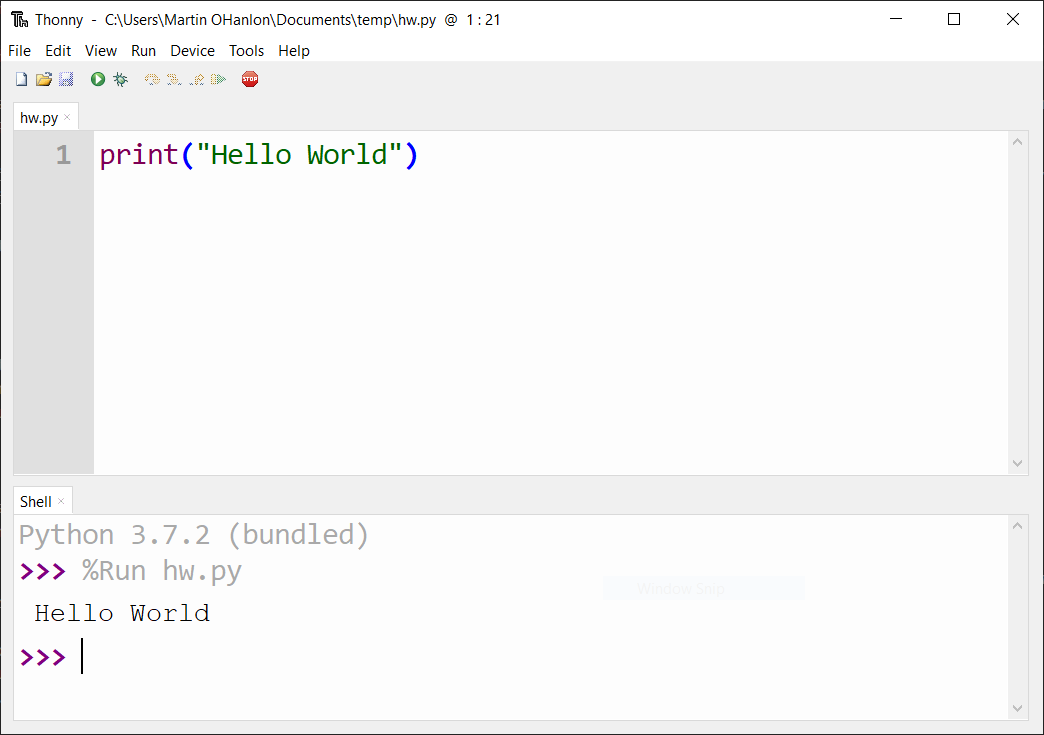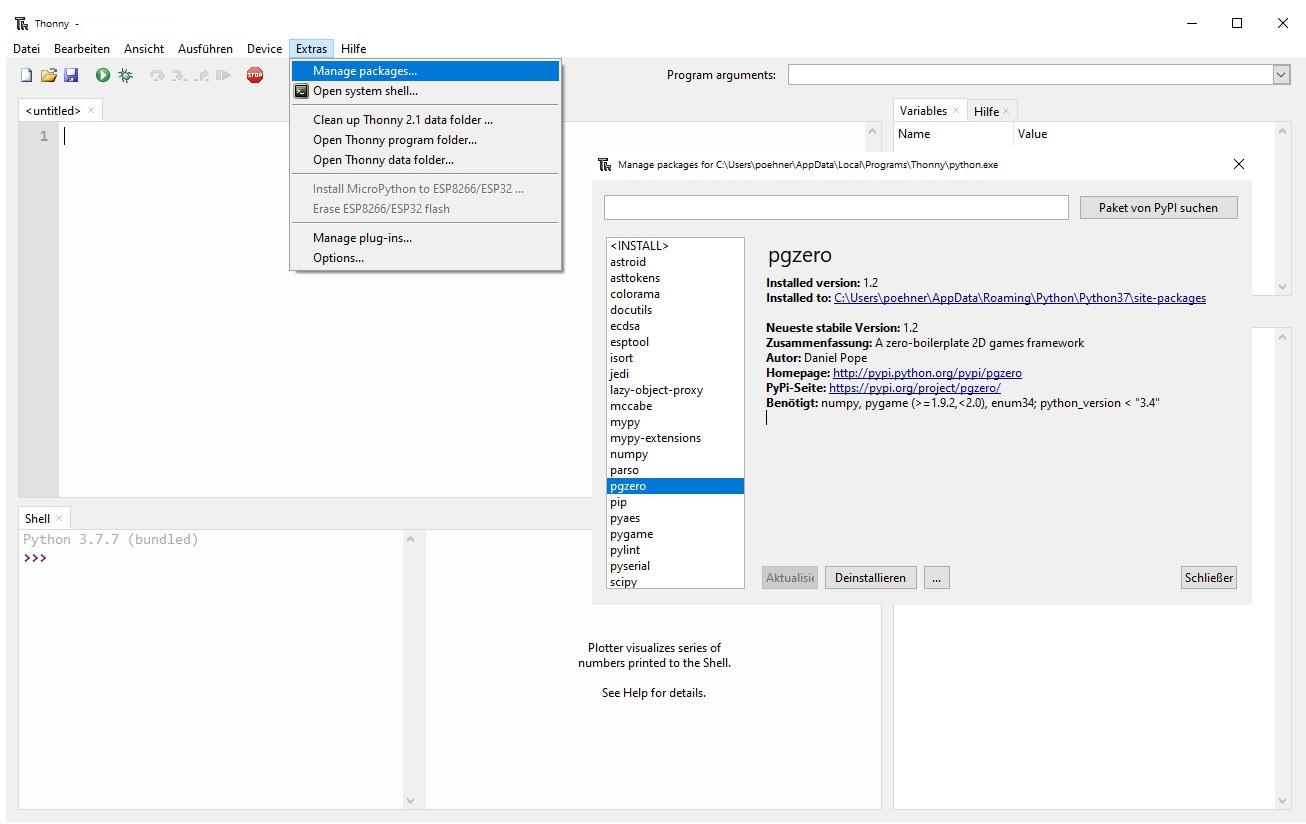

- #INSTALL THONNY ON RASPBERRY PI HOW TO#
- #INSTALL THONNY ON RASPBERRY PI INSTALL#
- #INSTALL THONNY ON RASPBERRY PI FULL#
- #INSTALL THONNY ON RASPBERRY PI SOFTWARE#
- #INSTALL THONNY ON RASPBERRY PI CODE#
#INSTALL THONNY ON RASPBERRY PI SOFTWARE#
It’s not perfect, I’m sure, but it is an excellent piece of software and well worth a go. Personally, I think everyone who writes in Python should take a look at Thonny. There are a lot of features (for which take a look at the MagPi article linked above) including step-through and variable debugging in Thonny that we didn’t touch the surface of, so I can only give you a surface-level opinion.

This makes it feel much more integrated than IDLE, and much tidier as a result.
#INSTALL THONNY ON RASPBERRY PI CODE#
Instead of the pop-up execution window you get with IDLE, Thonny runs the code in a Shell tab below the coding window.

Ben made a risky move and got us to use Thonny rather than IDLE, the de-facto editor for Python.
#INSTALL THONNY ON RASPBERRY PI HOW TO#
The workshop, which taught us how to use GPIO Zero’s remote control features, along with other examples using the library, was excellent. I recently attended a Raspberry Jam at Pi Towers and was lucky enough to take part in a workshop run by Ben Nuttall. The MagPi has done a great tutorial and walkthrough of the features of the editor here. Called Thonny, it has just been added into the Raspbian image.
#INSTALL THONNY ON RASPBERRY PI FULL#
However, most IDEs require a graphical interface to use, which means you will need to be on the full desktop version of Raspbian.There’s a new IDE (Integrated Development Environment) on the block. IDEs offer a number of benefits including syntax highlighting, code completion, one-click running, debugging hints, etc. Some users prefer to use an integrated development environment (IDE) when developing code. You are welcome to continue working through this guide using a text editor and command line.
#INSTALL THONNY ON RASPBERRY PI INSTALL#
Details on how to install or update the Raspberry Pi. nano, vim, emacs, Midnight Commander, Leafpad, etc.), save it, and then run it from the terminal with the command python. Once Thonny is installed, you will need to ensure that you are using the latest MicroPython firmware. The simplest way to create Python programs is to write your code in a text editor (e.g. You can confirm the package has been installed if it is listed under the Raspberry Pi Pico file listing in Thonny. py suffix is also necessary when making modules, which we'll cover later. Connect your Pico to the computer and fire up Thonny then using Tools > Manage Packages install the micropython-servo package onto your Pico. py, you will know that it contains Python code. However, it can be very helpful to keep your files organized so that when you see a file ending in. However, you can boot the Pico using any other. py is not required for the interpreter to run the code found inside. 1.We are going to show you to boot the Raspberry Pi Pico in BOOTSEL mode by connecting to a Raspberry Pi. py, the Python interpreter will run the commands found in the file without giving you an interactive session. To summarize what we just did, you can use the python command on its own to begin an interactive interpreter session that allows you to type commands in real time. Note: In case you were wondering, I am clearing my terminal between screenshots with the clear command. Once you press enter, you should see the phrase Hello, World! repeated back to you. Type the following command: language:bash You should be presented with a different command prompt, consisting of 3 greater-than signs >. Getting Started with the Interpreterįrom a terminal, enter the following commend to start the Python interpreter: language:bash If you are curious about where the phrase "Hello, World!" comes from, this Wikipedia article gives a brief yet fascinating history. This will show you two of the main ways to interact with Python. We'll do this first from the interpreter and then we'll create a file and run it as a program. To start, we'll tell Python to print the phrase, "Hello, World!" to the terminal. This will allow us to test out commands one line at a time! In fact, we can even run the interpreter in what's known as interactive mode. translate our program into machine code) in order to run our program. This means that we don't need to run a separate compile step (i.e. One of the coolest features of Python is that it is an interpreted language (OK, in reality, Python scripts are first compiled to some bytecode, and that bytecode is interpreted). You don’t need to configure anything related to Python. Click on the top left icon representing a raspberry > Programming > Thonny Python IDE. Once this is done, starting Thonny IDE is very simple. Share on Twitter Share on Facebook Pin It Hello, World! First, obviously, you need to install Raspberry Pi OS on a microSD card, for your Raspberry Pi board.


 0 kommentar(er)
0 kommentar(er)
